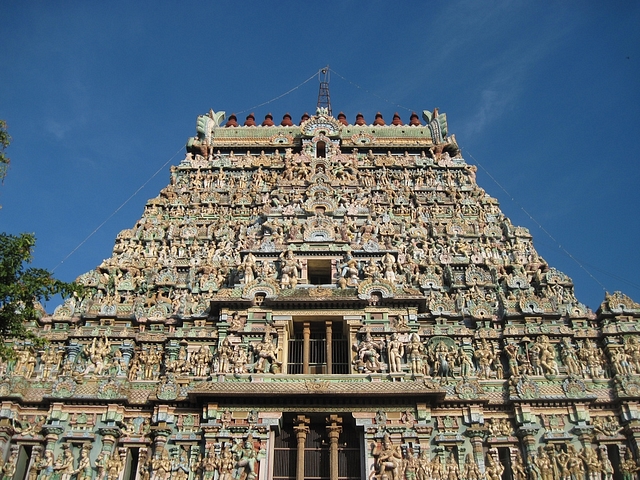
Temple Entry Reform And Sanatana Dharma
An Open Letter To Sri Sri Ravi Shankar
Dear Guruji,
Let me begin by stating that I am a big admirer of the work that you are doing to preserve, protect and propagate sanatana dharma. The work that the Art of Living is doing in various spheres of human upliftment is simply incredible. I am also impressed by your enthusiastic interventions to mediate peaceful solutions to long-standing geopolitical crises, be it at home or abroad.
However, I must confess that I have some concerns regarding the latest mediation that you have chosen to champion — seeking entry of women into the inner sanctum of the Shani Shingnapur Temple. Therefore, I thought of expressing my apprehensions to you in this letter.
Guruji, like you are aware, sanatana dharma is an ever evolving organic being which adapts to the challenges and needs of changing times. Perhaps, it is because of this unique feature that sanatana dharma is nutana (new) yet sanatana (old).
Unlike Abrahamic religions who are strictly bound by their Holy Books, we do not have scriptural limitations preventing modifications and adaptability of our traditions and customs. Traditions and practices that have been in vogue for many generations have existed independent of any scriptural basis.
Nevertheless, many of these traditions and practices have been recognised and respected as various attempts of man to realise the Truth. It is precisely because sanatana dharma permits such an incomparable level of spiritual and religious freedom, that we find the unparalleled diversity that exists in Hindu life today. This diversity is what makes this land and its people so incredible.
Sadly, a few persons who do not understand/appreciate the philosophical freedom of sanatana dharma, see diversity as discrimination. And therefore, they try to ‘correct the wrong’. It is sad that many well-meaning Hindus –many spiritual and political leaders included— find themselves in agreement with what such critics of Hindu traditions say.
While many may agree to think that it is ‘politically correct’ to join cause with the ‘progressives’, others may genuinely believe in what the critics are saying out of sheer ignorance. It is indeed for this reason that it becomes incumbent on influential spiritual and religious leaders like yourself to put things in the right perspective and protect the philosophical and spiritual freedom that sanatana dharmagives all of us.
I would have been happier if you had explained to the women seeking entry into the temple that the restriction on their entry into a particular part of the temple has got nothing to do with gender ‘discrimination’. You could have educated them that sanatana dharma has many traditions and practices that are gender specific, age specific and individual specific; that one-size fits all is a very Abrahamic religious idea, whereas sanatana dharma allows each to custom make his attempt at the realisation.
Because of this philosophical and theological freedom, there exist some men only temples and also some women only temples. Similarly, there are women-only festivals and there are men only festivals. There are male Gods, female Gods, and we have the ardhanaarishwara.
As someone hailing from Karnataka, you would know that in some parts, while Mangala Gauri Vrata is celebrated exclusively by the ladies of the house, the Ganesh Chaturthi is celebrated by the men only.
Likewise, there are some ceremonies that only married couples can perform, and there are others in which only non-married people participate. These classifications must not be misunderstood as discrimination. While Abrahamic and Marxist concept of unity are uniformity, sanatana dharma is capable of celebrating unity in diversity.
I am sure that you are aware that this mind-boggling diversity in sanatana dharma also extends to our practices in matters of marriage, adoption and inheritance. Even our law books, from Manu to today’s Constitution, have respected and recognised diverse customs and traditions as a legitimate source of law, unless of course, it is opposed to public policy.
Moreover, the doctrine of equality does not necessarily mean uniformity. All the main constitutions around the world which proclaim the equality of man, permit reasonable classification of men and objects, as the classification is recognised as a societal necessity.
What the Constitution prohibits is unreasonable discrimination of a certain class of people without an obvious reason for such discrimination. Confusing diversity for discrimination would blur the subtle difference that exists between proper classification and class discrimination and consequently, we would face the risk of losing all the diversity that we see living in India today.
This, however, does not mean that all practices and customs are infallible. It is also true that much reform needs to be done for removing unreasonable discrimination against women from many aspects of our societal life. But I am afraid that seeking entry of women into the Shani Shingnapur temple is the wrong medicine for the malaise.
For this reason Guruji, my request to you is not to proceed with your proposed mediation. It will be a blow to our much-prided unity in diversity.